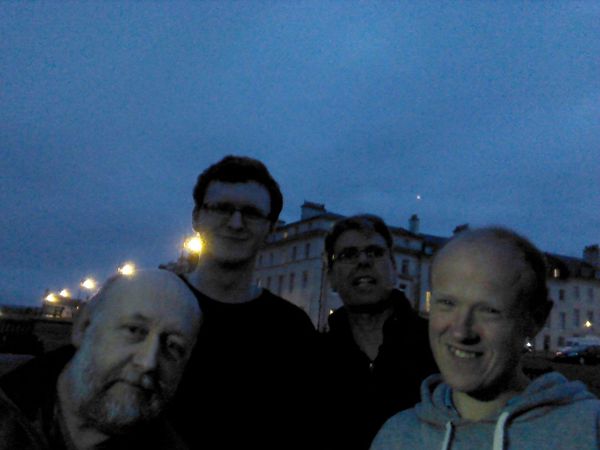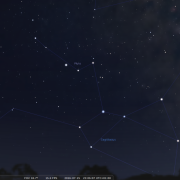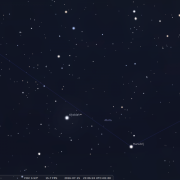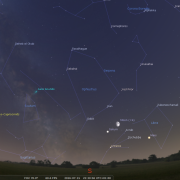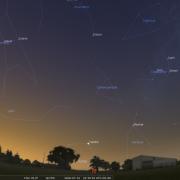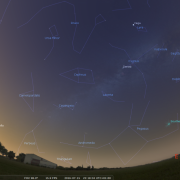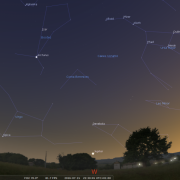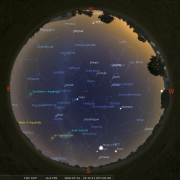Welcome to the WDAS monthly newsletter for July 2016: a digest of the month's latest contributions to our website. Below you'll find Society News, Sky Notes and In-Focus articles printed in full. There's also future events, and trailers for other articles which appear in full on the website - just a click away!
On the website you'll also be able to comment on articles, and if you'd like to play an editorial role in creating new content, just let us know!
Notice: Andy Lawrence is unable to attend tomorrow's (Saturday 2nd July) trip to the BAA Summer Meeting in York (see here) - a day of talks on cosmology. If you'd like to take his place, please reply straight away to this newsletter e-mail, or call Andi on 0161-408-4297.
Society News
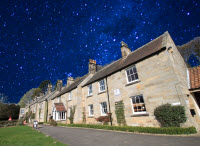 The society has been invited to the NYM Park Fest day on Sunday 24th July, to be held at the Danby Moors centre.
The society has been invited to the NYM Park Fest day on Sunday 24th July, to be held at the Danby Moors centre.
Predominantly a food and craft fair with a theme this year of ‘try something new’, we have been asked to provide some Mars bars, Galaxies, Milky Ways, Rocket biscuits and ‘planets’.... just joking. We have though been tasked with solar viewing, scaled solar system demos and anything else that may be considered adventurous.
The event runs from 22:00h-17:00h. Two free car spaces have been allocated to us and the attending charge has been waved. Further details will appear next month, but can also be found on the website.
What started out as a cloudy, chilly and blustery day, the evening seemed to be from a different season altogether, calm, clear and sunny.
Having been at a birthday party, Mark rushed up to the headland on the west cliff, for what proved to be the most successful star party so far this summer. The scopes were all deployed; the Moon was out, a few punters even managed to get a look. Then the cloud rolled in off the sea and in the space of 20 minutes skies were almost totally obscured. How nice. It was agreed that we are actually getting closer to holding a star party... sometime.
If you have not already done so, would members please find time to sign the online petition – re light pollution, set up by Wakefield Astronomical Society. This should have been sent via email to you already. A link will be given on our website. Ten thousand signatures (now reached!) are required for the Government to take note, and 100,000 for them to consider the subject for a parliamentary debate. The closing deadline is July 22nd. If you know anyone else who would be inclined to sympathise with the cause, get them to sign it too!
Sky Notes
In this month's Sky Notes:
Planetary Skylights
Three major planets are now visible in the late evening sky, Jupiter, Mars and Saturn.

 Jupiter continues to dominate the western sky as twilights deepens, although by the end of July it is only visible for a short while before setting. Observations are always fascinating: the location of the Galilean moons, the banding across the disk, and when on view, the size and colour of the great red spot, all add interest through the eyepiece. From the 12-14th Jupiter resides quite close to sigma Leonis, whilst on the 13th Europa passes in front of the Jovian disk with Ganymede on one side and Io and Callisto on the other. Observe around 22:30h. Our Moon is closest on the 8th and 9th
Jupiter continues to dominate the western sky as twilights deepens, although by the end of July it is only visible for a short while before setting. Observations are always fascinating: the location of the Galilean moons, the banding across the disk, and when on view, the size and colour of the great red spot, all add interest through the eyepiece. From the 12-14th Jupiter resides quite close to sigma Leonis, whilst on the 13th Europa passes in front of the Jovian disk with Ganymede on one side and Io and Callisto on the other. Observe around 22:30h. Our Moon is closest on the 8th and 9th
 Mars is on show low to the south, a conspicuous ochre beacon, gradually diminishing in brightness as we head through July. Do not confuse Antares (chief star in Scorpius) which resides lower left and is also of orange hue with Mars. It’s been a strange opposition period for Mars. Quite often when Mars reaches opposition the planet undergoes periods of turbulent dust storms, rendering much of the surface invisible to observation... annoyingly. This time around, a combination of factors has conspired to inhibit observations from Earth, particularly from the UK. The light nights, the position of Mars low on the ecliptic and especially the atrocious weather, all seemed to have restricted views through the scope to a pitiful level... annoyingly. Hopefully matters will improve with regard on the weather front... won’t it? The moon passes by Mars on 14th–16th.
Mars is on show low to the south, a conspicuous ochre beacon, gradually diminishing in brightness as we head through July. Do not confuse Antares (chief star in Scorpius) which resides lower left and is also of orange hue with Mars. It’s been a strange opposition period for Mars. Quite often when Mars reaches opposition the planet undergoes periods of turbulent dust storms, rendering much of the surface invisible to observation... annoyingly. This time around, a combination of factors has conspired to inhibit observations from Earth, particularly from the UK. The light nights, the position of Mars low on the ecliptic and especially the atrocious weather, all seemed to have restricted views through the scope to a pitiful level... annoyingly. Hopefully matters will improve with regard on the weather front... won’t it? The moon passes by Mars on 14th–16th.
 Saturn also resides low to the south, to the left of Mars, and having reached opposition last month remains a conspicuous object, its pearly white lustre contrasting nicely with ‘ruddy’ Mars. A telescope is required to see the ring system, look for the Cassini gap in the rings as well as several moons nearby. Titan, Saturn’s largest moon appears as a bright speck close by, orbiting anticlockwise twice a month. Our Moon resides above Saturn on the 16th.
Saturn also resides low to the south, to the left of Mars, and having reached opposition last month remains a conspicuous object, its pearly white lustre contrasting nicely with ‘ruddy’ Mars. A telescope is required to see the ring system, look for the Cassini gap in the rings as well as several moons nearby. Titan, Saturn’s largest moon appears as a bright speck close by, orbiting anticlockwise twice a month. Our Moon resides above Saturn on the 16th.
 Pluto reaches opposition on July 7th, but at magnitude +14, you will definitely require quite a large scope (10-inch plus) to identify it for certain. Pluto resides in the ‘teaspoon’ asterism which adjoins the ‘Teapot’ asterism in Sagittarius located not far above the south horizon around midnight.
Pluto reaches opposition on July 7th, but at magnitude +14, you will definitely require quite a large scope (10-inch plus) to identify it for certain. Pluto resides in the ‘teaspoon’ asterism which adjoins the ‘Teapot’ asterism in Sagittarius located not far above the south horizon around midnight.
|
General location of Pluto in
Sagittarius on 25-Jul-2016 at 23:00h
|
Teapot and Teaspoon |
Meteor Showers

A number of lesser meteor showers occur during July.
- The Capri-Cornids have 3 maxima, July 8, 15, and 26, but all have Zenith hourly rates (ZHR) of only half a dozen, the same as sporadic rates.
- The Alpha-Cygnids peak on July 21st, again rates are barely more than sporadic levels. Cygnus is well placed high in the SSE by midnight, but strong moonlight will interfere.
- The Delta-Aquarids are a little more prolific and peak on July 30th with a ZHR approaching 20. The light conditions outside do however restrict observations to a period between midnight and 02:30h.
July 2016 Sky Charts
Click each image to see a full-size Sky Chart:
|
Looking South
Mid-July - 22:30h |
Looking North |
|
Looking East
Mid-July - 22:15h |
Looking West
Mid-July - 22:30h |
|
|
|
|
Overview
9th-July - 22:30h |
|
Additional Image Credits:
- Planets and Comets where not otherwise mentioned: NASA
- Sky Charts: Stellarium Software
In-Focus
From mid-July, evenings gradually become darker once again, allowing more time for observers to explore and appreciate the summer constellations. The brightest stars emerge around 22:15h, isolated jewels dotted around the heavens. Of these, seven in particular catch the eye and three; Arcturus, Vega and Capella, are ranked in the top five brightest stars visible from our shores.
Let us begin at Arcturus, the brightest star visible for most of the year, second only to the winter star Sirius. You will locate the golden hue of Arcturus - meaning ‘guardian of the bear’ quite high in the west, residing in the constellation of Bootes - the Herdsman. At a distance of 37 light years Arcturus is the nearest example of an orange giant star, a ‘sun mass’ star in the latter stages of its life having converted all of its Hydrogen into Helium. In the distant future our Sun will evolve through a similar stage before ending its days as a planetary nebula. As twilight deepens further, note brilliant Capella in Auriga, found low above the N horizon. At this time of year Capella is often mistaken for the ‘north’ star, the true pole star; Polaris in Ursa Minor, resides some 54 degrees above the North horizon and is considerably fainter.
Swing back round to the WSW to locate Spica in the constellation of Virgo, soon to depart our skies. Like Capella, Spica is a spectroscopic double, each component bigger and more massive than our Sun and separated by just 17½ million km (11 million miles).
Our next destination is located not far above the South horizon. Antares, meaning ‘rival of Mars’ due to its deep orange hue, is the chief star in Scorpius, the outline of which does resemble that of a scorpion, though it only partly rises over Britain. Antares is a very tenuous ‘red super giant’ nearing the end of its life and is physically one of the largest stars readily visible to the naked eye, some 300 million miles in diameter. Astronomers believe Antares is a supernova candidate, one of only a few such bright examples visible in the night sky, however they are uncertain as to when this catastrophic event will occur. A word of caution when identifying Antares, Mars – the red planet, also resides low to the South, though is far brighter to the naked eye. The conspicuous white star to the left of this ‘ruddy’ pairing is the planet Saturn.
High overhead to the south and southeast are the three stars of the ‘summer triangle’. Rivalling Arcturus in brilliance, steely blue Vega, resides in the small geometric pattern of Lyra, the most Northern of the summer trio. Vega is a young star, possessing a disk of debris that may coalesce to form a planetary system. It lies just 26 light years away. Our next stop, Altair can be located in the ESE in the constellation of Aquila the Eagle and marks the southern point of the triangle. Still in the flush of youth, Altair is a star in a spin: an unusually rapid one, rotating in less than 6 hours and would appear rugby ball shaped up close. Altair has the distinction of being closest of the bright summer stars visible from Britain, a mere 16 light years away.
Our final destination is currently located high to the ENE in the constellation of Cygnus. Deneb is visually the least conspicuous of the ‘summer triangle’ and indeed our magnificent stellar seven. Appearances though can be deceptive. Its immense distance of around 1600 light years hide Deneb’s true nature, a stellar superstar, a genuine heavy weight, 25 times more massive and at least 150 thousand times more luminous than our Sun.
Although just a few million years old, Deneb’s high initial mass dictates its rate of evolution, which is extremely rapid, converting energy at a prodigious rate so that even now all of its Hydrogen has been used up. This ‘time bomb’ is ticking and in little more than 15 million years Deneb will evolve into a star almost twice the size of Antares, finally ending its brief life in cataclysmic fashion, as a supernova. On that day our descendents will marvel at this spectacular stellar death, a wonder to all in our galaxy... and beyond.

